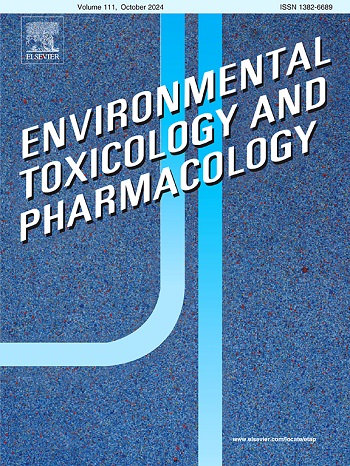Novel miniaturized exposure to evaluate the toxicity of Enniatin B1 on Daphnia magna
IF 4.2
3区 环境科学与生态学
Q2 ENVIRONMENTAL SCIENCES
引用次数: 0
Abstract
Enniatins (ENNs) are a heterogenous group of mycotoxins that are commonly detected in several commodity items, food and feedstock. Although this class of compounds shows several toxicological properties, studies so far mainly investigated the effects of ENN B, neglecting other prevalent molecules such as ENN B1, one of the most detected mycotoxins in food. Despite ENNs have been detected in freshwater, regulatory efforts have only focused on limiting the levels of these molecules in food, while limited investigations assessed their toxicity towards organisms. This study aims at expanding the knowledge on the effects of ENN B1 through a miniaturized in vivo approach using the freshwater cladoceran Daphnia magna as model organism. A 7-day exposure was performed under miniaturized conditions to assess the effects of two concentrations of ENN B1 (i.e., 0.25 and 1.5 µM). After the exposure, effects on survival, activity of antioxidant and detoxifying enzymes, body size, reproductive outcomes (i.e., presence of eggs in the brood chamber) and swimming activity were investigated. Whilst EEN B1 did not affect survival and enzyme activities, significant changes in body length and egg appearance were observed. These findings highlight the potential toxicity of ENN B1 on a freshwater species suggesting the need of further studies to assess its risk for aquatic organisms.
新型微型暴露评价叶青素B1对大水蚤的毒性
乳突菌毒素(ENNs)是一组异质性真菌毒素,通常在几种商品、食品和原料中检测到。虽然这类化合物显示出几种毒理学特性,但迄今为止的研究主要是研究新新n B的影响,而忽略了其他普遍存在的分子,如新新n B1,这是食品中检测最多的真菌毒素之一。尽管在淡水中检测到ENNs,但监管工作只集中在限制食品中这些分子的水平,而有限的调查评估了它们对生物体的毒性。本研究旨在以淡水纲动物大水蚤为模式生物,通过小型体内方法,扩大对ennb1作用的认识。在小型化条件下进行了为期7天的暴露,以评估两种浓度的新氮B1(即0.25和1.5 µM)的影响。暴露后,研究了对存活、抗氧化和解毒酶活性、体型、繁殖结果(即育雏室中卵的存在)和游泳活动的影响。虽然EEN B1对存活率和酶活性没有影响,但观察到体长和卵外观发生了显著变化。这些发现强调了新氮素B1对淡水物种的潜在毒性,表明需要进一步研究以评估其对水生生物的风险。
本文章由计算机程序翻译,如有差异,请以英文原文为准。
求助全文
约1分钟内获得全文
求助全文
来源期刊
CiteScore
7.00
自引率
4.70%
发文量
185
审稿时长
34 days
期刊介绍:
Environmental Toxicology and Pharmacology publishes the results of studies concerning toxic and pharmacological effects of (human and veterinary) drugs and of environmental contaminants in animals and man.
Areas of special interest are: molecular mechanisms of toxicity, biotransformation and toxicokinetics (including toxicokinetic modelling), molecular, biochemical and physiological mechanisms explaining differences in sensitivity between species and individuals, the characterisation of pathophysiological models and mechanisms involved in the development of effects and the identification of biological markers that can be used to study exposure and effects in man and animals.
In addition to full length papers, short communications, full-length reviews and mini-reviews, Environmental Toxicology and Pharmacology will publish in depth assessments of special problem areas. The latter publications may exceed the length of a full length paper three to fourfold. A basic requirement is that the assessments are made under the auspices of international groups of leading experts in the fields concerned. The information examined may either consist of data that were already published, or of new data that were obtained within the framework of collaborative research programmes. Provision is also made for the acceptance of minireviews on (classes of) compounds, toxicities or mechanisms, debating recent advances in rapidly developing fields that fall within the scope of the journal.

 求助内容:
求助内容: 应助结果提醒方式:
应助结果提醒方式:


